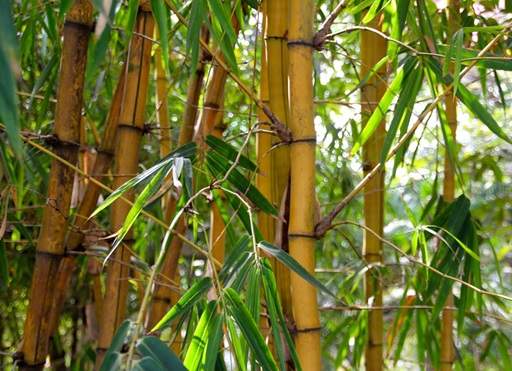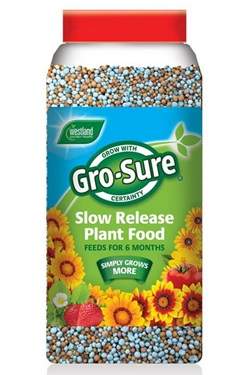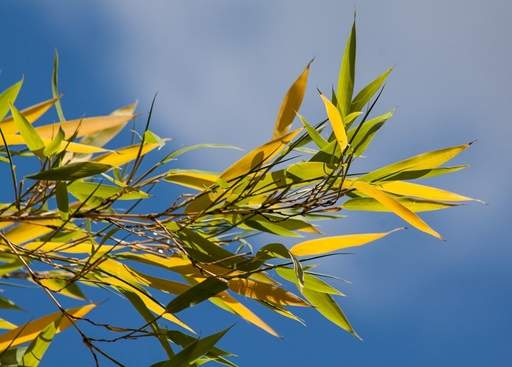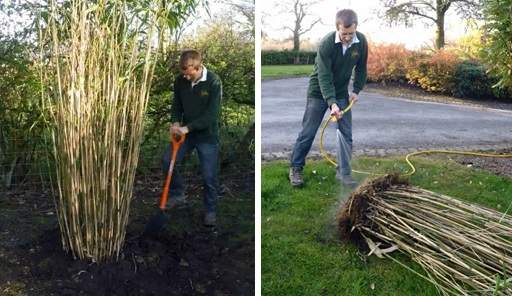How to plant, grow and care for bamboo
Bamboos are valuable ornamental plants with attractive, lush evergreen foliage that can be used to add a tropical effect, style, movement and panache to any garden. Easy to grow and fully hardy, they come in almost 10,000 varieties ranging from huge tropicals to tiny dwarfs, and have become increasingly popular and fashionable over recent years for a variety of settings. With a few hundred varieties being suitable for the British climate, they are ideal for using as focal points, adding structure, height and movement to your borders or implementing as a windbreak, hedge or screen.

Choosing a type of bamboo
Clump forming vs. running bamboos
- Bamboos can be divided into clump-forming and running varieties, both having specific uses and benefits.
- Running bamboos spread by rhzomes (horizontal underground stems) which help the plant to colonise new areas and may spread aggressively if not contained. They are great for quickly forming a windproof hedge or screen providing the roots are constrained to your desired growing area.
- Clump-forming bamboos spread slowly because, like ornamental grasses, the growth pattern of the root mass is to expand more gradually. Clump forming bamboos work well as big specimen plants in lawns or as mixed border plantings and they are easier to keep in containers than running bamboo.
- As a rough rule of thumb, clump forming bamboos tend to grow 30-60cm (1-2 feet) taller each year with running varieties growing 90cm-1.5 metres (3-5 feet) taller each year.

Types of Running Bamboo
Phyllostachys aureosulcata f. spectabilis
Pleioblastus pygmaeus Distichus
Types of Clump-Forming Bamboo
How to plant bamboo
When to plant
- Bamboos are suitable for planting all year round, although if you have a particularly cold, exposed garden planting outdoors sufficiently early to allow the bamboo to become established and harden off prior to their first winter is recommended.
- Planting in spring is ideal as it means the food reserves in the rhizome can be used to fuel a fresh flush of canes over the first summer.

Aspect and Hardiness
- Different bamboo varieties have different sun and shade preferences. Phyllostachys (comprising a large number of the tall growing, running varieties) do best with 5 hours or more of sunlight per day, whilst Fargesia, Thamnocalamus and Sasa prefer light to moderate shade. It's really a function of the particular species so best to check for the variety you are interested in.
- Some bamboos are very hardy plants, originating from the mountainous regions or lowland plains of Asia where winter temperatures can drop as low as -25 to -30 degree Celsius. Others originate from Africa, Australia and tropical parts of Asia and are best protected from cold, drying winds.

Soil Type
- Bamboos are not fussy, tolerating most soil types, but generally grow best in a moderately acidic, well-drained, loamy soil in a sheltered spot.
- Bamboos need to be kept well watered during the growing season but will not tolerant wet feet at cooler, wetter times of the year. If you have a very heavily, clay soil it's best to incorporate gravel or grit when planting.

Spacing
- Space mature plants 1 metre apart to form a dense screen. Fast Growing varieties can be planted a little further apart if you don't mind waiting longer for them to fill in the gaps.
- Most bamboos will not suffer from being planted almost back to back if you want an instant screen.

Planting
1) Dig the planting hole 1.5 to 2 times the width and depth of the bamboo root mass and work compost or manure into the dug soil to provide a nutrient boost. Add one third grit in heavy soils.

2) Leave a generous layer of compost at the bottom of the hole so that the rootball sits slightly lower than the original depth, so that 2-3cm (1 inch) of soil will cover the original surface after backfilling.

3) If your plants are heavily pot bound, tease out the roots to stop them from circling in on themselves. In some cases you may need to make a few cuts with a sharp knife to free the roots.

4) Give the rootball a good soaking before planting, ideally dunking it in a large bucket of water for 20 minutes so the water seeps right into the centre of the rootball.

5) Backfill and firm the ground down well when finished, being careful not to damage young rhizomes.

6) We don't normally recommend adding fertiliser at planting time but if you choose to, make sure it's in the top 30cm (1 foot) of topsoil rather than at the bottom of the planting hole. This is particularly important if you are growing running bamboos to avoid encouraging the rhizomes to grow more deeply, which would make your root barrier ineffective and root pruning more difficult.

Feeding is not normally recommended at planting time but if you do fertilise, use a slow release multi-purpose feed and apply it to the top 30cm (1 foot) of topsoil
7) Water thoroughly to eliminate air pockets, then mulch with compost, grass, hay, leafmould or manure.

8) Mulching with bark around the base of your bamboo and where you want it to grow will further aid water retention. Protect smaller bamboos from overexposure to the hot sun, particularly if planting shade lovers such as Fargesia in the height of summer.

For advice on growing bamboo in a container please see our article on how to plant, grow and care for bamboo in containers.
Containment of Running Bamboos
Option 1 - Installing a physical constraining barrier
- Keeping running varieties under control and attractive is relatively easy if planting instructions are followed carefully and routine maintenance is undertaken. However, they do merit a word of caution - they can become invasive, unsightly and spread beyond their bounds if left unrestricted and unchecked.
- A physical constraining barrier and/or root pruning will keep your running bamboo looking beautiful and restrict it to its designated space.
- Planting your running bamboo inside a properly installed barrier will prevent it from spreading through beds and borders. When planting, dig a trench at least 2 feet (60cm) but ideally 4 feet (1.2 metres) deep and for the length of your desired planting and line the sides with root barrier fabric, high density polythene available from builders merchants or solid materials e.g. paving slabs or corrugated iron sheets.
- The barrier should stick out at least 7.5cm (3 inches) above soil level to prevent the bamboo stems arching over the top. It can be disguised with decorative mulch or stone.
- When rhizomes meet the barrier, they will turn and sometimes go down. For this reason it is important to firm the soil down securely to eliminate loose soil and air pockets, otherwise the rhizomes may go deeper than you want and potentially under the barrier.
Option 2 - Regular root pruning
- Checking for unwelcome, spreading rhizomes and root pruning if required is the next option. Root pruning should be done bi-annually in spring and autumn for running bamboos.
- Root pruning involves working around the bamboo with a sharp spade, driving it into the ground and removing any rhizomes outside of the area where you'd like the bamboo to grow.
- Rhizomes are usually small-rooted and prefer to grow in loose topsoil, which makes the exercise more straightforward. Small segments of rhizomes can rejuvenate, so be thorough. The exception is if you have a very light soil, in which case you may find the rhizomes a little deeper.
- To make root pruning easier, maintain a shallow trench with a depth and width of 25-30cm (8-12 inches) around the bamboo, or at least along the edge where it is adjacent to a lawn or path.
- Check for creeping rhizomes a couple of times in the late summer and early autumn to see if any of them have tried to cross the trench; if so, remove them. If a trench is impractical for the planting environment, it can be filled with a loose media, such as sand, which is easy to dig into for root cutting.

Root pruning bamboo
Planting within physical barriers and root-pruning is not normally necessary for clump-forming bamboos, although lifting and dividing every other year is encouraged (more details below).
General Garden Care
Watering
- Bamboos require frequent and liberal watering when first planted to become established. For the first growing season we recommend watering twice a week during mild weather and 3-4 times a week during very hot days in the height of summer. Insufficient water especially on hot, dry, windy days is the main cause of weak growth or failure. Drought tolerance is built up as your plants become established.
- It's equally important to ensure excess water can drain away freely so your bamboo plants don't sit with wet feet for more than 24 hours. Make sure the area drains well and doesn't collect pools or ground water for long periods of time.

Bamboos require frequent and liberal watering
Feeding and Mulching
- The more you feed, the more your bamboo will grow. Clump-forming varieties respond well to feeding. Running varieties are already vigorous and feeding will just make them more invasive. Unless you have constricted the roots and want your running bamboos to fill out to create a screen, we recommend against feeding running bamboos.
- If you choose to feed your bamboo, use general purpose plant food or a high nitrogen lawn feed. Apply once in early spring and again in the summer to match the two main growth seasons of bamboo.
- Keep the area around your bamboo plants well mulched, keeping the mulch 2 inches (5cm) away from the outer canes to prevent disease. Mulching helps preserve moisture and maintain an even temperature around the roots of your plants.

Feed bamboo plants with a general purpose plant food or high nitrogen lawn feed
Pruning
- Dead, damaged, weak, unattractive and spindly canes should be cut right back to the ground with loppers or secateurs in spring. This will open up your plants, allowing more light and air into the centre to keep them healthy. Fallen leaves, grass cuttings, cane sheaths and other debris will build up around the base of your plant. It's best to remove this at the same time as pruning.
- You can prune your bamboo plants without fear of damaging them. Make your secateur cuts just above a node, so as not to leave a stub that will die back and look unsightly.
- You can ease congestion of mature plants by pruning off some side branches. If you have to cut back some canes at the top, shortening side branches will also make your plants look more natural and balanced.
- It's possible to create a more striking effect by removing all side branches and foliage at the base of your plants so the beauty of the canes can be fully appreciated.
Caring for bamboo in containers
- Bamboo in containers require more care because it makes them more susceptible to environmental stress. They are more sensitive to heat and cold, strong winds tip them over, and the restricted root space means they will dry out more quickly.
- They should be watered regularly - every other day in the summer, ensuring that the pot drains well - and protected from frost and ice in the winter.
- For more information please see our article on how to plant, grow and care for bamboo in containers.

Yellowing and falling leaves
- Whilst bamboos are evergreen they do renew their leaves, so having some leaves falling from your plants is perfectly natural and healthy.
- In spring, expect to see considerable yellowing of some leaves, followed by leaf drop. This is particularly a feature for Phyllostachys and Fargesia varieties.
- Fallen leaves will be replaced by fresh new ones. It's very normal to see a combination of green leaves, yellow leaves and newly unfurling leaves in the spring.
- However, if large parts of your plants turn yellow, you probably have a problem. This could be caused by poor soil, insufficient nutrients, too much or too little water or stressful growing situations.
- Make sure you are providing sufficient water particularly on hot, dry days; if not, step up the watering.
- Conversely, if you have a heavy, clay soil make sure water does not 'puddle' around the base; if it does, consider lifting and replanting with plenty of grit (even planted in a raised mound) to improve drainage.
- If your bamboo is in a windy, exposed site, install a windbreak to provide some protection.

Lifting and Dividing Bamboo Clumps
- The best time to lift and divide clumps is mid-spring, before the growing season. In order to hydrate the plant and reduce the risk of transplant shock, water your bamboo thoroughly the night before you divide.
- Gently loosen the soil around the clump with a fork, being careful not to damage any of the rhizomes below ground, then gently lift them out of the ground.
- Shake excess soil from the root ball, rinse with water to reveal the bamboo root system and inspect the rhizomes for natural points of division.
- Depending on the amount of crowding in the ground or pot, the size of the pot and the number of divisions desired, split the rhizomes into two, three or four sections using a saw, axe or mattock.
- Any old, rotten or otherwise damaged roots should be discarded to discourage fungal infection and encourage healthy growth.
- One of the divided sections is best planted back in the original garden location or container, whilst others can be used elsewhere in the garden.
- When starting from a new planting or small plant division, you can expect to see new shoots grow only slightly taller than the previous year canes.
- If you prefer to dispose of the extra rhizome sections, allow them to dry out and die before discarding in the compost pile, otherwise they may set root in the nutrient-rich environment of your compost heap!

Bamboo Flowering
- The popular belief is that bamboos always die after flowering. This isn't always the case, although your plants will be left substantially weakened. Some simple steps can give your plants the best chance.
- The good news is that flowering occurs infrequently and can sometimes just be the odd tall, feathery flowering shoot, rather than the whole clump bursting into bloom.
- Cut out any odd flowering shoots as soon as they're discovered to discourage more from forming.
- If the whole clump bursts into bloom, allow it to do so even if the foliage starts to turn brown and look lifeless. Carry on watering and feeding throughout.
- Then, cut the whole clump back to ground level the following spring and feed sparingly with lawn feed or another high nitrogen fertiliser to encourage new culms to develop from the base.
Share this page:




